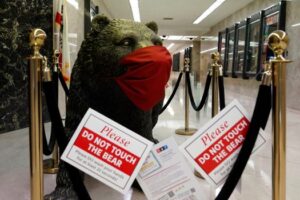This is not the time to lift mask requirements for California classrooms.
No, we’re not there yet.
For the past few weeks, Californians have been witnessing a politically fueled national push to lift mask mandates not only in red states but also in blue ones. Perhaps most disturbing is the misguided insistence by some on abandoning masks in our children’s classrooms, which only exacerbates an already challenging effort to keep schools open.
The debate among public health experts is not over whether to lift indoor mask mandates, but when. The data indicate that, despite the political push, now is a time to show patience — to keep wearing masks in public indoor spaces.
“Every time after a surge we tend to loosen up a little too soon, so we leave ourselves at a higher level of cases than before the surge started, and we keep building on that,” says Dr. John Swartzberg, a clinical professor emeritus at UC Berkeley’s School of Public Health. “And I see the same thing happening right now with omicron.”
We’ve repeatedly seen that premature rush to loosen restrictions from California Gov. Gavin Newsom, whose lifting of indoor mask mandates for vaccinated people in public spaces takes effect today. Fortunately, some local jurisdictions, such as Santa Clara County, where health officials are exercising reasonable caution, are keeping mask mandates in place for everyone.
Despite the political push, the data show the rush to ditch masks is premature. Omicron hospitalization rates in California are still 17% higher than during the peak of the delta era. Deaths are 37% greater.
While California is witnessing a steep drop in the number of COVID cases from the unprecedented omicron peak last month of 735,000 cases in just one week, the latest weekly counts are still 2½ times as great as during the delta surge and are on par with the peak of last winter’s onslaught.
The current case numbers are undoubtedly undercounts because of the ramp-up of unreported home testing. Nevertheless, the trendline is pointing in the right direction. But we’ve got a significant way to go before we should be easing up.
And there’s no guarantee the downward trend will continue. As examples, consider the leveling off of cases in South Africa and the United Kingdom, where omicron surges hit before the United States. They experienced sharp declines in case counts after the peak, but then saw that abruptly end.
Meanwhile, in California, four UCSF doctors are conducting a misguided push to return to pre-COVD normal in classrooms by dropping mask requirements for kids. It’s mind-boggling. And it has created a split at the prestigious medical teaching facility, with some of the top UCSF experts pushing back, saying such a move is premature.
“Compared to sending everybody home every time there’s a case, masks are a much less intrusive kind of intervention,” says Dr. George Rutherford, UCSF professor of epidemiology and biostatistics.
Our top two defenses against the coronavirus remain vaccinations and masks. Only 65% of California children ages 12-17 are vaccinated, and only 29% are vaccinated and boosted. As for kids ages 5-11, only 28% are vaccinated.
That leaves masking for about half the state’s K-12 students as the primary defense against the spread of the virus. This at a time when, for reasons that are not fully understood yet, children make up a larger share of COVID-19 hospitalizations than at any other time of the pandemic.
For now, Newsom and his health secretary, Dr. Mark Ghaly, have postponed a decision on school masking until Feb. 28. For the sake of our kids, their teachers and their families, let’s hope that the governor and Ghaly show more resistance to political pressure on school safeguards than they did when prematurely lifting indoor masking for the general population.



















